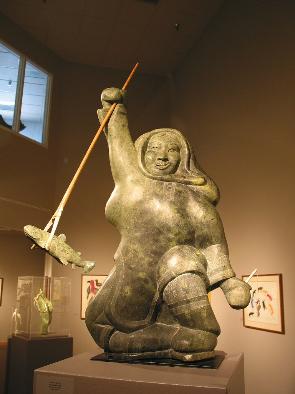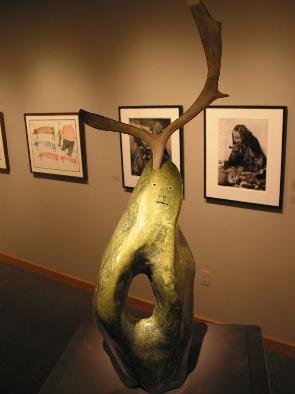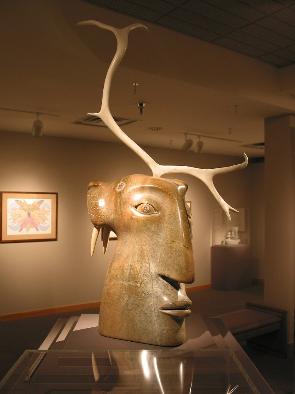Loveland Museum/Gallery hosts an exhibit examining Western influence on Inuit art.
By Laura McWilliams / Rocky Mountain News
Original article
In his introduction to the show Survival: Inuit Art, Denver psychiatrist Dr. Samuel Wagonfeld describes his first experience with Inuit art as a “chance
visit to a gallery ‘north of the border.’” He adds, “The freshness of the strange and bold images, their imagination and wonderful appeal were
different from traditional Western art and captivated me.” His Inuit art collection, one Wagonfeld began after this chance encounter is on view in a
beautiful exhibit at the Loveland Museum/Gallery.
The Inuit are a people who have lived for thousands of years in a circumpolar region stretching from Siberia around the globe to Greenland.
Survival examines the art and culture of the Central Canadian Inuit.
The Canadian Inuit were until very recently a nomadic people living in small hunting bands. Contact with European explorers as early as the 16th
century affected Inuit culture and traditions as explorers, traders and missionaries brought with them useful materials such as metal and wood but
also introduced foreign diseases, money and trade into the traditionally subsistence economy.
Still, many Inuit continued to follow traditional ways until the 1950s, when changes in caribou migration routes and an ebb in the fur trade led to a
time of mass starvation and death among the people. The Canadian government stepped in to offer humanitarian assistance, resettling Inuit
groups in permanent villages throughout Canada. The government built churches, schools and houses, and administered social welfare programs.
It also introduced trades such as printmaking to many communities as a means of economic independence.
This period in the 1950s is the beginning of what Wagonfeld refers to as “a golden age” of contemporary Inuit art.
I expected this show to be strong on history and to emphasize traditional artistic styles and methods. The Loveland Museum/Gallery does a good
job of presenting a condensed version of modern Inuit history (if you’re interested, be sure to look through the show’s catalog). But I was surprised
by the wide variety of styles on view in the show. The exhibit consists of drawings, carvings, wall hangings and prints. The pieces are beautiful and
range from austere and simple prints to complex symbolic drawings and sculptural objects.
In addition, the earliest works differ greatly from more recent art. The earliest pieces are largely free from connections to Western art, but the more
recent Inuit art includes many subtle and not-so-subtle references to European systems of representation.
Much of the earliest prints, drawings and carvings in Survival illustrate a way of life that ended with the resettlement. The Inuit who lived through the
starvation period of the 1950s and the move to villages often idealized the lives they left behind, depicting bountiful lands and effortless hunts.
Drawings and prints by Luke Anguhadluq (1895-1982) depict a subsistence existence. His works include pictures of swimming caribou, hunters in
kayaks and fishers with fish. Anguhadluq turned the paper as he worked, conflating time, space and perspective as he strove to describe an image.
Kiakshuk (1886-1966) is described by the show’s catalog as “a well-known storyteller in the community” who “became highly respected for his
ability to translate oral history, tales of the hunt, of animals, family life, or shamans and spirits, into graphic media.” His “Hunting Seals and Polar
Bears” nearly takes the form of a manual for Inuit hunters. The flat graphite drawing shows diagrammatic images of a hunter trapping and spearing
a polar bear and fishing a seal out of an ice hole. His stonecut print, “Hunting Whales,” from 1961, depicts five large blue whales pursued by two
kayaks and one larger boat. This is a view of an idyllic land of plenty in which animals nearly outnumber Inuit and the hunting is easy and clean.
In contrast to the older generation, many younger artists make work that depicts stories passed on through generations by a strong oral tradition.
Much of this work illustrates shamanistic myths, Inuit legends or historic stories.
Victoria Mamnguqsualuk (b. 1930) is, according to the gallery’s artist description, “one of the best known Canadian Inuit artists of her generation.”
Her simple drawings are retellings of Inuit myths and legends. “Brother Moon/Sister Sun” presents an illustration of a creation myth and incest
taboo that describes the formation of the sun and the moon. The story runs from the paper’s bottom left corner and ends at the top, describing a
legend in which a girl is kissed by a stranger in the dark. When she discovers that the stranger is her brother, the two flee in shame into the sky to
become Sister Sun and Brother Moon.
Kenojuak Ashevak (b. 1927) uses animal shapes as vessels for her explorations of line, color and positive and negative space. “Bird with
Feathers” presents a legless bird surrounded by its own flowing, red-tipped, bulbous feathers. The bird shape is filled with obsessive, regular
scribbles that give form to the animal and which also serve to shade and highlight the rounded creature. The image is beautifully balanced with the
negative space of the white paper, and the delicate lines counteract the heavily geometric bird-and-feather form.
The drawings, prints and sculptures in this exhibit are enchanting and beautiful, and the formal choices of artists such as Anguhadluq and Ashevak
are delightfully innovative. But it is the dichotomy of Inuit/European that is most intriguing. The clear Western influence evident in much of the work
(English titles and captions, occasional attempts at realism and perspective) conflicts with the Inuit culture that is the exhibit’s subject matter.
This exhibit includes a nice variety of subjects and styles, and presents artwork from a large number of artists. It teaches a bit about Inuit history
and culture while allowing viewers to enjoy a truly gorgeous art show.
• • • • •
Survival: Inuit Art runs through October 3, 2004 at the Loveland Museum/Gallery, 5th and Lincoln, Loveland. For information, call 970/962-2410.
|
|
|



